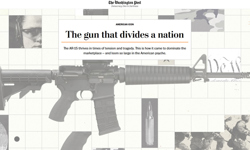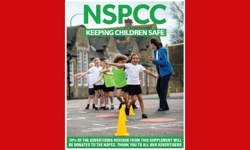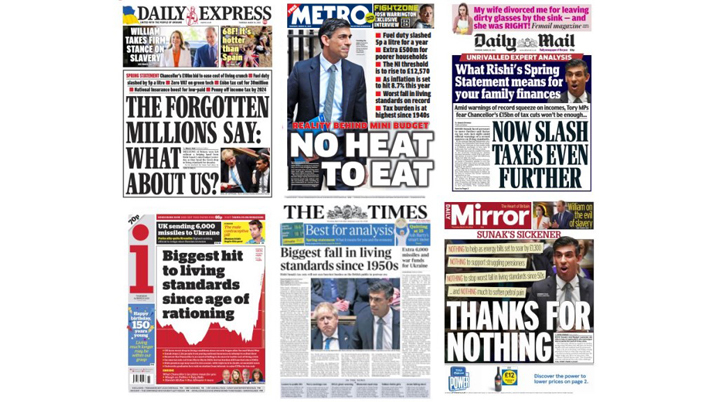
That went well, didn’t it?
When even your bestest of best friends think you’ve messed up, you can be pretty sure you got it wrong.
And so it has been for Rishi Sunak this past week. The Chancellor, dealt one of the worst hands in the history of budget management, thought he was playing aces, but they turned out to be twos or jokers. Hint: the market stallholder’s “Not 1p, not 2p…” line doesn’t work when you’ve already told everyone it’s going to be 5p.
Did he really think no one would see through a promise of a penny off income tax the month before the next election is due? Even the Sun asked “Why now?” in a leader that pointed out, “By then the economy may be unimaginably worse off. If he has to U-turn, Labour will eat the Tories alive.
“Besides, two years is an eternity to wait for a minor tax break when rampant inflation is already gobbling up your pay or pension. Sorry, Rishi. We're not convinced it's the election-clinching move you think it is.”
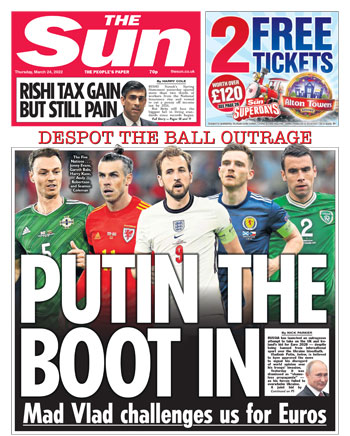
That post-spring statement Sun was something of a collector’s item. First of all, it did its best to ignore the whole event, limiting it to a tiny box under the titlepiece, preferring to splash on “Putin the boot in” – Russia’s no-hope bid to host the Euros. That little taster tried to put the best gloss on the Chancellor’s efforts, accentuating the positive with all its might, while unable to ignore the negative. The headline “Rishi tax gain, but still pain” summed up the approach perfectly. “Rishi Sunak’s spring statement spared more than two-thirds of workers from the National Insurance rise and vowed to cut a penny off income tax by 2024,” read the intro. Cheers all round then.
But as we know, it wasn’t. Indeed, that leader offered only two of the traditional three. Inside (way back on pages 10 and 11) was a neatly turned spread “For Rishi, far poorer” in which the positives (again coming first) were highlighted with green graphics, the negatives on the opposite page with red ones.
Then there was the op-ed column alongside the leader “The Rish list” in which eight “struggling” households were asked what they thought. Each of these case studies was accompanied by a figure showing how much they had gained or lost as a result of Wednesday’s announcements. Everyone apart from the woman on universal credit had a plus figure. For the UC woman it was “no change”. The “widow” had +£43.75, the “pensioner” +£66, the “working family” +£441. So why were they all unhappy? Because the figures were for a year, not a week. And everyone knows that all of these people’s bills will rise by a lot more than any of those numbers.
But what about the poor people?
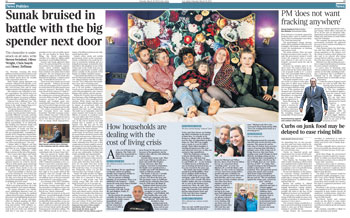
At least the Sun had some ordinary people as its case studies. If the Chancellor has come under fire for being a wealthy man out of touch, perhaps someone might have a word with the Times.
If there’s one tip for newspaper readers (which they will never heed), it is to ignore the day-after headlines, wait a day or two and then venture into that unknown world of the weekend Money sections. Here, writers who know what they’re talking about have time and space to drill down into what any budget really means to people – including the bits hidden in the small print – without having to produce instant analysis or worry about the political argy-bargy.
These are almost uniformly excellent and the Times was true to form with its “From student loans to pensions: what Rishi Sunak didn’t tell you” . But back on the news pages, oh, the case studies.
“As the cost of living crisis develops we will follow four households to find out how they are coping,” it promised. Starting with “the company boss”, earning more than £150,000 a year (we don’t know exactly how much more), who is worried that his children’s private school fees are bound to go up. Then there’s the “squeezed family” who run a luxury holiday studio business and live in a five-bedroom house in Hertfordshire. They’re starting to buy yellow-sticker food. Followed by the thirtysomething couple (he’s a web developer, she’s in customer services) saving £200 a month towards buying their first home. They are having to economise on their mobile phone contracts. And finally, the pensioners living in an eco-house on the Isle of Wight. Besides the state pension, they have more than half a million pounds in separate pension pots. They are starting to eat out less.
All of these families deserve a place in any mix of how any financial policy is affecting people across the country. But does no one earning just the average wage, in a low-paid job or out of work, no one under 30, no bachelor, single parent, widow or divorcée, no one caring for a relative or paying care home fees read The Times?
Concern for the well-off
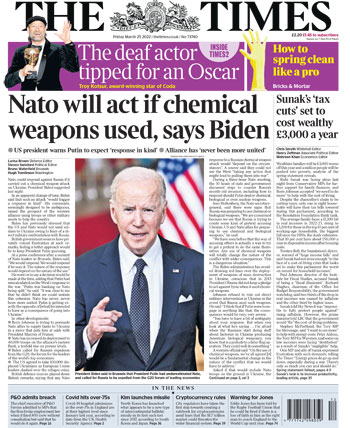
Naturally every news organisation will home in on the angle that will resonate with its audience. We had seen it before in the Times’s day two front-page headline “Sunak’s ‘tax cuts’ set to cost wealthy £3,000 a year”. The idea was clearly to point up the disjunct between a supposed tax cut and people being left worse off. But after 48 hours of people of all political stripes (including the Thunderer) asking “what about the poor?”, it did jar somewhat. Especially when you got to the intro that told us: “Wealthier families will be £3,000 worse off this year and a million people will be pushed into poverty, analysis of the spring statement reveals.” For whom does the reader’s heart bleed?
The story goes on to define these wealthier families as the top 10% of working-age households, who have about £56,000 in their pockets after they’ve put a roof over their heads. The report doesn’t put a number on how many households this is – or even explain what a “working age household” is. If it’s any household with someone between 16 and 64, then, according to last year’s census analysis, there are 21 million of them. (The census analysis also tells us that about 60% of households with people aged between 16 and 64 have everyone in work, and about 14% where none is in work.)
So by that token, there would be twice as many families £3,000 worse off than would be thrown into poverty. Perspective, perhaps? Wouldn’t it have been nice to know how many the Times was talking about? Even if they are probably better able to withstand a 5% drop in living standards than the nurse dependant on a food bank.
Perspective, perhaps? Wouldn’t it have been nice to know how many the Times was talking about?
The cost of living crisis
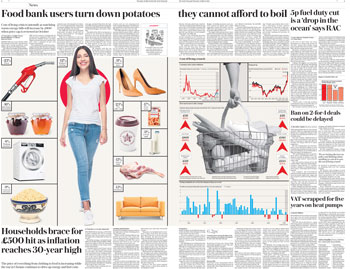
Those food banks were, of course, at the front of minds of those who didn’t have to suffer the Tory paper angst of putting a positive gloss on Sunak’s statement. “Cost of living surges: and Sunak squeezes poorest” was the Guardian’s splash (don’t know why that colon was there), while the Mirror sneered “Thanks for nothing”.
So much, so predictable. But the Guardian found an unusual co-traveller at the food bank, where the Telegraph reported on clients declining potatoes they couldn’t afford to boil – a rather more arresting image than the Guardian’s “no cause to celebrate”. The Telegraph also stole the march on its left-wing rival with a display of where prices have risen. It took the Guardian a day to catch up – preferring a rail of tops to the Telegraph’s full-length pretty woman to represent clothing inflation.
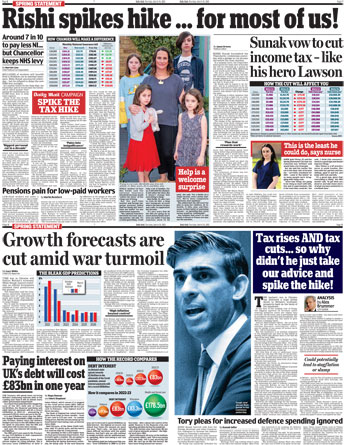
It was also noticeable that the Telegraph, in common with the Times and i, led not on anything Sunak had said, but on “biggest drop in living standards on record” (The Times had “since the 1950s” and the i “since the age of rationing”.)
The loyalist Express and Mail were also unhappy. “The forgotten millions say: what about us?” was the Express lead – meaning pensioners, who were the central focus of two of the three inside spreads. The Mail meanwhile bellowed “Now slash taxes even further”. It was clearly infuriated that the Chancellor hadn’t heeded its demands that he “spike the hike”, ie ditch the NI contributions increase that is supposed to fund the NHS and social care (one day). Or had he? The 6-7 spread was “Rishi spikes hike…for most of us!” – while on page 13, Alex Brummer’s analysis was headlined “Tax rises AND tax cuts…so why didn’t he just take our advice and spike the hike!” (More weird punctuation, isn’t this a question rather than an exclamation?)
Suggestions, anyone?
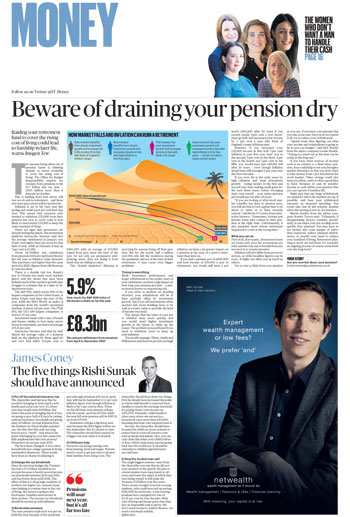
Most agreed that Sunak had an impossible task and there were plenty of pundits to tell him where he had gone wrong – but beyond “spike the hike”, there were few suggestions as to what he might have done better. Should he have cut income tax now? Should he have raised universal credit? Should he have borrowed more? The Tory papers were reluctant to offer solutions – because, to be honest, there are none that will please everyone. There are only palliatives. The Express, as ever, wanted pensions increased, the Telegraph wanted spending cut. The Sunday Times’s James Coney came closest with “five things Sunak should have announced”. They included putting off that NI rise and raising pensions, but he also homed in on factors that didn’t, perhaps, get the attention they deserved on day one: frozen tax thresholds, student loans and childcare.
Sunak may have promised to cut income tax by a penny in time for the election, but thresholds have been frozen for two years and will continue to be so – so more people on lower incomes will be paying tax, whatever the basic rate.
Changes to the student loan system, with its almost usurious interest rates, were announced earlier this month while everyone was busy looking at Ukraine. The income level at which graduates must start repaying their loans has been frozen and the point at which the debt is written off has been put back from 30 to 40 years. This was duly reported, but not necessarily with the fervour associated with migrants in small boats or woke cancel culture. This week, we saw exactly what it meant for the Treasury: £35bn over five years (almost enough to cover the bill for Test and Trace). As Coney put it: “That's money straight from low-earning students, who could now end up paying £100,000 for university. A low-earning graduate has a marginal tax rate of 42.25 per cent for four decades. With cost-of-living and house-price rises, they face an impossible task to get by.”
The Telegraph described this as a “£150 stealth tax” that was Sunak’s biggest earner; the FT said the Chancellor was under fire over “student cash cow”; the i reported that students were being “hit for billions”. The Mail has never been a fan of students or universities, so maybe it was unsurprising that it took the line “Making students pay back early will save £35bn”. The Express is so fixated on filling elderly pockets that it didn’t care enough even to report it. Remember, this is the generation that has carried the heaviest pandemic burden to protect those Express pensioners.
Back to Coney and his final concern: childcare. He says the threshold for the withdrawal for child benefit should be raised to match the higher-rate tax band, so that basic-rate payers don’t lose it. He also calls for the childcare hours scheme to encompass all nursery costs, including meals and admin, and be available for younger children (at present it is open only to those aged 3 and 4), to encourage parents back to work.
Whether or not you agree with these suggestions, here was a writer with more to say that “don’t hit my special interest group”. Hurrah for that.
Forecourt PR
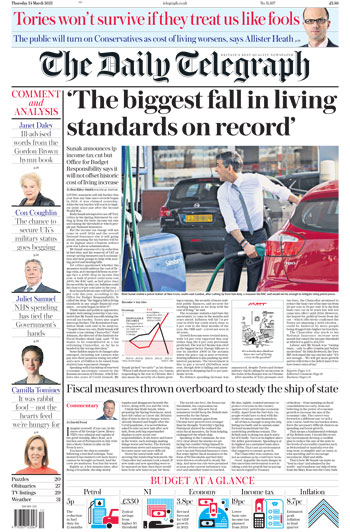
The hostile – or at best ambivalent – coverage of the Chancellor’s statement mostly made a refreshing change from the tendency just to regurgitate whatever the government says. In words, at least. Pictures were another matter. Or one picture in particular. There he was, on the front of the Telegraph, “filling up”, shortly after announcing the cut in fuel duty. He also bought a can of Coke and a Twix at the Sainsbury petrol station and managed to make a mess of paying for it all.
Does zillionaire Rishi Sunak drive a Kia Rio? Does he only put thirty quid’s worth of petrol in at a time? Of course he doesn’t. Did anyone think to ask before printing the picture? Er, not really. The Telegraph seemed to have doubts, captioning the picture “visited a petrol station”, while the Mail had him “topping up his tank”, the Sun, Metro and Times had him “filling up”. The Times did at least note that “Sunak’s official photographer snapped him…” and the Guardian had him “posing”. Only the i and Express gave the picture a swerve.
Much hilarity ensued when others reported that this was a Sainsbury worker’s car. But it was too late. No matter how much fun they poked after the event, and no matter how much the caption writers wriggled to avoid saying outright “this is a stunt”, there’s no getting away from the fact that the papers used the pictures (three in the case of the Sun) and were thus used by the Chancellor.
The Prime Minister has a personal photographer; his two biggest rivals for his job – Sunak and Liz Truss – are busy branding themselves through Insta accounts loaded with official photographs. The three of them have turned the pandemic, war and a cost-of-living hell into a succession of self-promoting photo-opportunities. Often at taxpayers’ expense. (Sunak was at it again the next day in high-viz jacket and goggles.) I find this distasteful, but if that’s what they want to do and it’s legal, so be it.
But I’ve said again and again, just because someone poses, it doesn’t mean the Press has to print the resultant picture. It’s easy, it’s cheap, it’s convenient. But it’s also news management. All that high-minded “calling the powerful to account” and demands for the freedom to be as nasty as we like in the interests of democracy come to nothing if we simply pump out the stuff handed to us on a plate rather than get our own photographs. And to ridicule it afterwards is mere cake-ism.
Just because someone poses, it doesn’t mean the Press has to print the resultant picture.
That went well, didn’t it 2: The Caribbean adventure
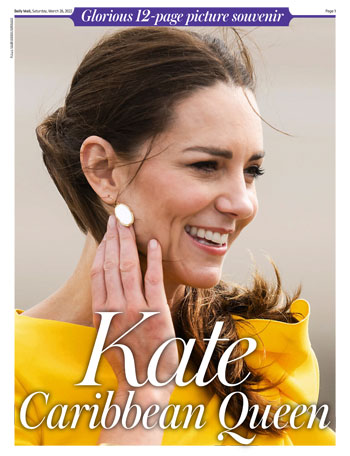
The writing was on the wall right from the beginning. “William and Kate in tour storm” provided a splash for the Mail on the Saturday the couple flew out to Belize: the first stop on the tour was being cancelled because of anti-colonialism protests. But everyone loves the Cambridges, don’t they. So on Monday, we had Caribbean Kate “queen of the maracas”, on Tuesday it was “Khaki Kate’s adventure in the jungle”, on Wednesday “Diving duchess and a close encounter with jaws”, and after a hiatus for Rishi and the Queen, Saturday brought a “glorious 12-page picture pullout” of our “Caribbean queen”.
The Express and Sun were just as gushing, between them giving us Kate the jungle VIP, Kate the belle of Belize, Kate the mover and shaker and more. It reached a pitch with the Sun’s “One’s love” splash last Friday, with the front page dominated by a picture of William gazing into his wife’s eyes. This was supposed to be an homage to Bob Marley. All three had spreads, day after day, about how wonderful the couple were and how everyone loved them. Oh yes, and William made a speech saying slavery wasn’t a good thing, but didn’t actually apologise for it. The Prime Minister of Jamaica told the couple his country was likely to become a republic, but that didn’t spoil the love-in.
And, look at this, here they are in the very same Land Rover the Queen and Prince Philip rode around in in 1966 and 1994. Land Rover of Hope and Glory, the Sun called it on a spread in which Kate looked “radiant” stirring memories of “the Queen and Phil”.

Yes, but…
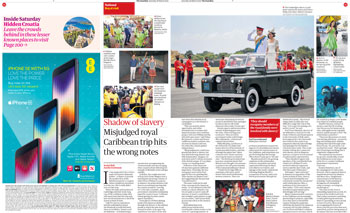
All pretty much par for the course. Except commentators elsewhere were busy saying the tour was a disaster, with its echoes of colonialism, children separated from the couple by wire fences; the rise of republicanism. So much so that by Saturday, columnists were seriously contemplating the future of the monarchy and the Commonwealth. You would expect the Guardian to be sceptical, but the Times, Telegraph and Mirror were all less than fawning.
In the end, even the Express, Sun and Mail had to admit it hadn’t been as happy and glorious as they’d been suggesting for the past week. But William was on it; things were going to change. Matt Wilkinson, author of that “Land Rover of hope and glory” piece the day before, produced an oped describing the tour as a wake-up call and a burst of “industrial strength smelling salts” for the family.
At the Mail, Rebecca English wrote of “Royal tour hit by claims of tone-deaf PR and colonialism” while Jan Moir said William “couldn’t have been more colonial if he had worn a pith helmet and driven a tank through the streets of Kingston”. That view was countered by Robert Hardman saying the fact the couple didn’t ignore the crowds at the fence proved they were wonderful and the “Twitter-driven battalions of the perpetually offended” were wrong.
It goes without saying that for the faithful, it was incompetent flunkeys and inept Foreign Office types who were to blame for any failings of this tour, but it may yet provide a reality check. For the Royal Family at least. The tabs might need more persuading. For them, royal tours are still a feast of radiant princesses and gallant princes, with restless natives merely an irritating little distraction from the fashion show. For now.
In the end, even the Sun and Mail had to admit it hadn’t been as happy and glorious as they’d been suggesting for the past week.
Look who’s back
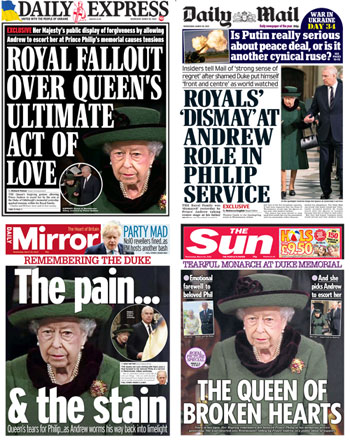
And then there was Andrew. The Queen’s first public appearance for months, at the memorial service for the Duke of Edinburgh, was a shoo-in for the front pages. But who expected her disgraced son to steal some of her limelight and cause a “royal fallout” by escorting her to her pew? For the Mail and Express, the key point was that Charles and William were “dismayed”; for the Sun it was affirmation that Andrew was the favourite son. Now who was that service about again?
Missing the main story
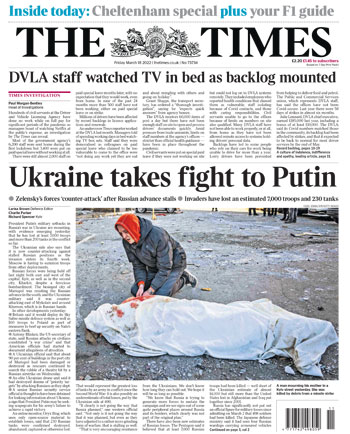
Déjà vu time and another case of the curse of the exclusive. Last time it was Denise Van Outen’s autobiography in the Sun, this time it’s a DVLA investigation. A worthy enterprise that occupied one of the three elements on the Times front page a couple of Fridays ago. The other two were the war and a Cheltenham Gold Cup puff. But the story everyone was talking about was P&O – which made its first appearance on the 14-15 spread, way behind 11 pages of war and a story about napping and dementia.
A lot of planning goes into these sorts of stories – whether it’s serialising a book or your own investigation, but you have to run them when people will take notice, not stick to your calendar and ignore a breaking story.
Meanwhile the Telegraph had the ferry company on its front, but with the wrong headline. Sheikh does what? This is about 800 people being sacked on zoom. It’s not hard.
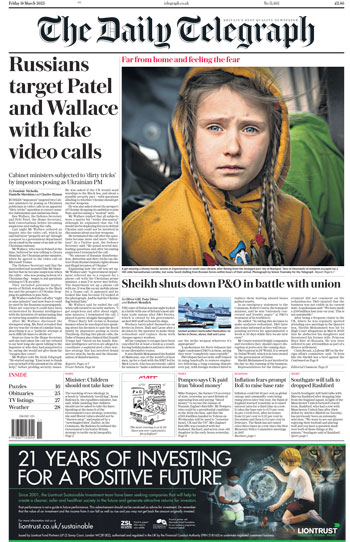
Oscars coverage: frock-free
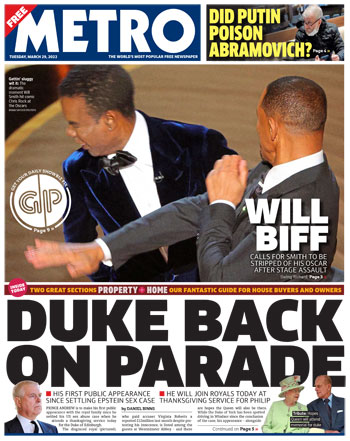
What was I saying last time about the Baftas and Fleet Street’s unwillingness to stray from the prescribed format to report on the real story? So happy to be proved wrong by Will Smith’s appearance on every front page on Tuesday. And not a posh frock in sight. There is hope.
Front page of the fortnight
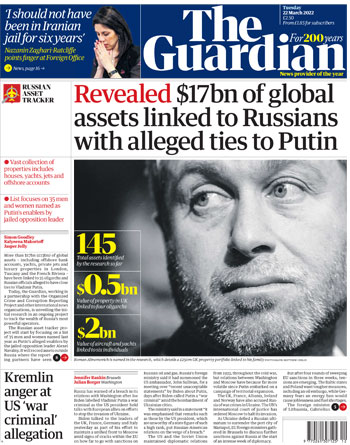
A second successive appearance for Roman Abramovich – and before his apparent poisoning.
This number-crunching exercise is the sort of thing the Guardian does so well. Well-researched and well-presented, this – not official handouts – is what journalism is about.
PS: Partygate hasn’t gone away.
Liz Gerard’s Notebook is a fortnightly column published in the InPubWeekly newsletter. To be added to the mailing list, enter your email address here.







